
 Alex Chauvancy
The Hockey Writers
Alex Chauvancy
The Hockey Writers
37
Reads
0
Comments
Ruff’s Stint With the Stars Gives Devils Glimpse of Future
The New Jersey Devils’ coaching search finally came to an end earlier this week. And it didn’t come without a surprise, as they announced Lindy Ruff would take over behind the bench.
Ruff had spent the last three seasons as an assistant for the New York Rangers. Before then, he was the head coach of the Dallas Stars for four seasons. And that stint provides a glimpse of what he’ll bring to the Devils as their head coach. Here’s a year-by-year breakdown of his time in Dallas and what to expect moving forward.
2013-14: A Sign of Things to Come
Stars’ 5-on-5 stats and league rankings:
- Corsi share (CF%): 50.5% (14th)
- Expected goals share (xGF%): 50.93% (10th)
- Corsi per 60 minutes (CF/60): 57.55 (8th)
- Corsi against per 60 minutes (CA/60): 56.42 (20th)
- xG per 60 minutes (xGF/60): 2.39 (3rd)
- xG against per 60 minutes (xGA/60): 2.30 (21st)
The 2013-14 season marked Ruff’s first as the Stars’ head coach, and it served as the blueprint for what kind of hockey the team played during his tenure. They were a middle of the pack possession team (CF%) but fared well in controlling the share of expected goals (xGF%). What was most notable was they were playing fast-paced, high-event hockey. They generated a lot of shot attempts (CF/60), as well as quality ones (xGF/60), but the tradeoff was they gave up a fair bit of each in the defensive end (CA/60, xGA/60).
As far as individual performances go, Tyler Seguin had a breakout season in what was his first with the Stars. He finished with 84 points in 80 games, a big jump from the 32 points in 48 games he had the previous season with the Boston Bruins, and averaged 2.77 points per 60 minutes (points/60) at five-on-five. His most common linemates were Jamie Benn, who had 79 points on the season, and rookie Valeri Nichuskin, who finished with 34 points in 82 games. So Ruff found a good fit for Seguin to help him become a top-line center right away.
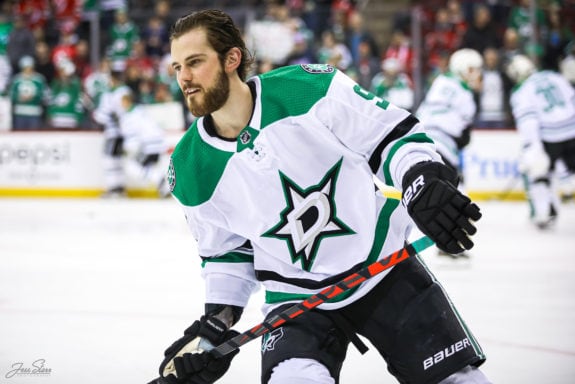
The Stars were not a great defensive team, nor did they have the best defensive personnel. But Alex Goligoski had one of the best seasons of his career, finishing with 42 points in 81 games. That was the second time he’s reached 40 points in a single season, and the first time he had since 2010-11.
In net, the Stars got some solid goaltending from Kari Lehtonen, as he finished the season with a .919 save percentage (SV%) in 65 games played. Combined that with enough offense from Benn and Seguin, and the Stars were able to sneak into the playoffs as the final wild card team, with 91 points and a 40-31-11 record, their first postseason appearance in five years.
2014-15: Stars Submarined by Goaltending
Stars’ 5-on-5 stats and league rankings:
- CF%: 52.16% (10th)
- xGF%: 52.6% (10th)
- CF/60: 61.67 (1st)
- CA/60: 56.57 (23rd)
- xGF/60: 2.49 (2nd)
- xGA/60: 2.25 (22nd)
Ruff’s second season with the Stars saw some noticeable improvement in their 5-on-5 stats. Both their CF% and xGF% increased by about 1.5%, ranking them in the top 10 of the league in each stat. But what stood out most is the rate at which they generated shot attempts. Over the last 10 seasons, only 15 teams have averaged more CF/60 than the 2014-15 Stars, and plenty of them were repeats. The Carolina Hurricanes did it three times (2013, 2017-18, 2018-19), while the Montreal Canadiens and Vegas Golden Knights did in each 2018-19 and 2019-20. So this version of the Stars was one of the fastest-paced of the past decade.
The Stars also had a few significant additions to their roster for the 2014-15 season. They acquired Jason Spezza from the Ottawa Senators, and he settled in nicely with his new team, finishing with 62 points in 82 games as a second-line center.
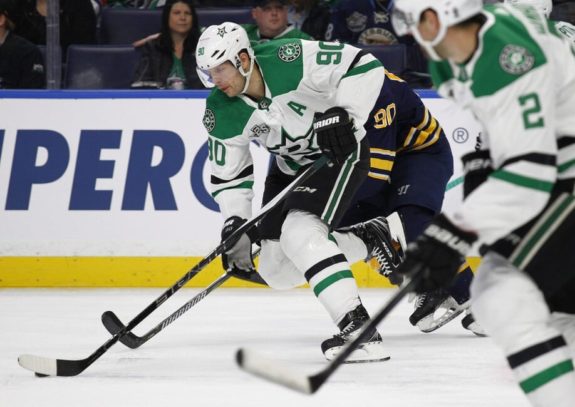
Ruff’s second season with the Stars also marked John Klingberg’s first NHL season. The 22-year-old rookie defenseman had a strong debut campaign, as he finished with 40 points in 65 games. He averaged close to 21 minutes of ice time a night and finished fifth in Calder voting for Rookie of the Year. They also got a 38-point season from Trevor Daley, as well as 36 points from Goligoski. So there was a substantial improvement in production from their blue line.
The Stars also took one-year flyers on Patrick Eaves and Ales Hemsky, both of whom provided scoring depth. Eaves had 27 points in 47 games, a 48-point pace over 82 games, while Hemsky had 32 points in 76 games. Combined with Benn’s 87 points and Seguin’s 77 points, and the Stars finished with 257 goals, second-most in the league to the Tampa Bay Lightning, who had 259.
Related: Devils Hiring Ruff Would Mean Fast-Paced Hockey
Where things went south for the Stars was in net. After a strong season the year before, Lehtonen finished with just a .903 SV%. As a team, they had a .895 SV%, ranked second to last in the NHL. The Stars still totaled 92 points and a 41-31-10 record, but there’s no doubt they make the playoffs had they gotten just league average goaltending.
2015-16: Ruff’s Offensive Juggernaut
Stars’ 5-on-5 stats and league rankings:
- CF%: 52.56% (3rd)
- xGF%: 52.75% (5th)
- CF/60: 61.46 (2nd)
- CA/60: 55.47 (19th)
- xGF/60: 2.50 (1st)
- xGA/60: 2.24 (20th)
This Stars team ended up as Ruff’s best during his time in Dallas, and it’s not close. They were one of the best possession teams, as well as one of the best in controlling xG. They were also arguably the fastest-paced team in the league, which led to a high-octane offense that scored a league-leading 265 goals, 17 more than the second-place Washington Capitals. The downside is they gave up quite a few shots, in quality and quantity, but it didn’t matter much with an offense as potent as theirs.
At an individual level, the Stars had a scary amount of scoring depth. Benn, Seguin, and Spezza all finished with 30-plus goals and 60-plus points; Benn even won the Art Ross Trophy as the league’s leading scorer with 89 points. It was also Patrick Sharp’s first season with the Stars, and he played a significant role in the offensive spike, as he had 20 goals and 55 points.
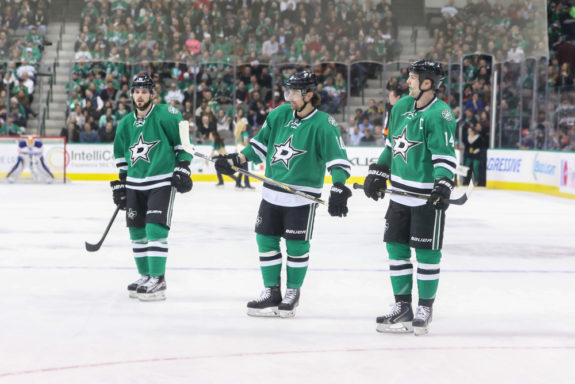
On defense, Klingberg emerged as one of the NHL’s best puck-moving defensemen. He finished with 10 goals and 58 points, ranked fourth in scoring on the Stars. He finished with a goals above replacement (GAR) of 15.4, ranked eighth among all defensemen in the league, thanks to his even-strength offense and work on the power play.
If there was an area where the Stars had problems, it was in net. Lehtonen finished with a .906 SV% but had a goals saved above average (GSAA) of minus-9.57. His backup, Antti Niemi, didn’t fare much better, as he had a .905 SV% and GSAA of minus-11.93, the fifth-worst GSAA in the league.
Related: Devils Hire Ruff as Head Coach
But unlike the year before, the Stars’ offense was so lethal it was able to make up for their defensive and goaltending woes. They finished the season with a 50-23-9 record and 109 points, both of which were tops in the Western Conference, giving them the no. 1 seed in the playoffs. They’d go on to make it to the Western Conference semifinals, where they’d lose in seven games to the St. Louis Blues.
2016-17: Downhill in a Hurry
Stars’ 5-on-5 stats and league rankings:
- CF%: 50.08% (17th)
- xGF%: 50.12% (18th)
- CF/60: 58.21 (5th)
- CA/60: 58.01 (26th)
- xGF/60: 2.34 (6th)
- xGA/60: 2.33 (27th)
The 2016-17 season marked a significant downturn for the Stars. After being a top 5-10 possession team in Ruff’s first three seasons, they now ranked in the league’s bottom half. Defense was never a strength of theirs, but they were now giving up enough shot attempts and xG per 60 minutes to rank in the bottom five of the league. And their attack wasn’t as formidable as it was in past seasons, even though their CF/60 and xGF/60 were still among the league’s top five or six.
When it came to individual performances, the Stars lost some of the firepower they had previously. Sharp finished with 18 points and only played in 48 games due to injuries. Seguin and Benn still had strong seasons, but they weren’t producing at the point-per-game paces they were accustomed to. They got some depth scoring from Eaves and Devin Shore, but it wasn’t anywhere close to what they had in 2015-16. After being one of the two highest-scoring teams in each of the past two seasons, the Stars finished with 222 goals, ranked 17th in the NHL.
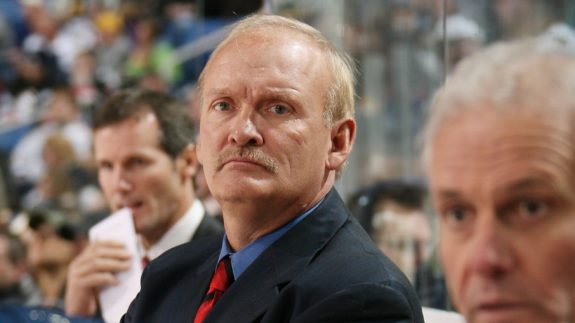
Because their offense dried up, their defensive flaws became more pronounced. They gave up 260 goals, the second-most in the league. Part of that is because of personnel changes; Goligoski was traded to the Coyotes, while Jason Demers left as a free agent. Klingberg still had an impressive season, but the loss of talent on the blue line was too much to overcome.
And to make matters worse, Lehtonen had a .902 SV% and GSAA of minus-17.15, third-worst in the league, while Niemi had a .892 SV% and GSAA of minus-18.78, the worst in the NHL. Sure, the Stars’ defensive woes didn’t help either netminder. But the team’s goaltending was not good in any shape or form, which contributed to the downturn.
The result was the Stars finishing with a 34-37-11 record and only 79 points, a 30-point swing from a season ago, which led to management firing Ruff after four seasons. His time with the Stars ended with a 165-122-41 record and two playoff appearances.
What Ruff Brings to Devils
It’s pretty clear the Devils are going to play fast-paced, high-event hockey under Ruff (he said as much in his introductory press conference). The question now is, “do they have the pieces to play that way?” Jack Hughes, Nico Hischier, Jesper Bratt, and Nikita Gusev are pretty good building blocks. You can probably throw Kyle Palmieri and Jesper Boqvist in the mix too.
But the Devils will need to acquire a couple of puck-moving defensemen to do so. Ruff’s system succeeded best in Dallas when Klingberg, Goligoski, Demers, and Daley led the blue line because they could move the puck effectively. Otherwise, a fast-paced system won’t work if the defensemen can’t move the puck up the ice cleanly to their forwards to start the attack.
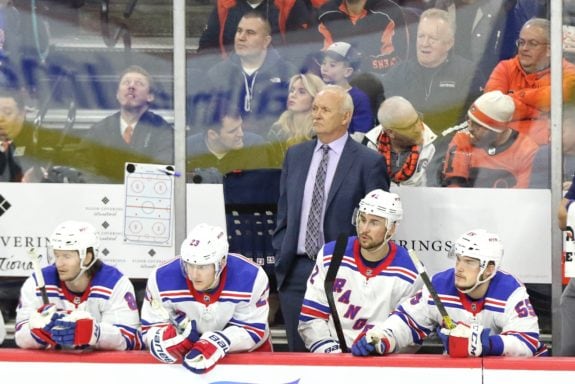
The Devils have a couple of decent puck-moving blueliners in Damon Severson and Will Butcher. It’ll also help if P.K. Subban can find his game again. But even if he does, general manager Tom Fitzgerald will have to make additions. Erik Gustafsson will be one of the more effective puck-moving defenders on the free-agent market this offseason. They could also trade for someone like Colin Miller, who could use a change of scenery.
The Devils must shore up their goaltending situation, as well. Mackenzie Blackwood is the real deal, but he needs a legit backup. Two goaltenders that come to mind are Cam Talbot and Anton Khudobin. They’ll both be free agents this offseason and would be ideal 1Bs to Blackwood. And don’t rule out Robin Lehner, either, if his contract demands aren’t outrageous.
Related: Devils Should Pass on Sanderson at 7th Overall
I’m pretty confident Ruff will improve the Devils’ offense, perhaps significantly. He played a major role in turning Seguin and Benn into star players, so that bodes well for Hischier and Hughes. The biggest question facing the Devils is what they’ll look like defensively. And it’s something they’ll have to address in building Ruff’s staff. But if their offense and goaltending are strong enough, they can get by with a below-average defense.
Overall, Devils’ fans should expect something completely different than former coach John Hynes‘ slow-paced style of hockey. Instead, look for a ton of speed from Ruff’s system. And if they make the right additions, they could be one of the fastest-paced teams in the league soon enough. That should make for some exciting hockey, even if their defense doesn’t improve.
* * *
Advanced stats from Natural Stat Trick, Evolving Hockey
The post Ruff’s Stint With the Stars Gives Devils Glimpse of Future appeared first on The Hockey Writers.
Popular Articles

















































 Blackhawks Chicago
Blackhawks Chicago Panthers Florida
Panthers Florida Penguins Pittsburgh
Penguins Pittsburgh Rangers New York
Rangers New York Avalanche Colorado
Avalanche Colorado Kings Los Angeles
Kings Los Angeles Maple Leafs Toronto
Maple Leafs Toronto Bruins Boston
Bruins Boston Capitals Washington
Capitals Washington Flames Calgary
Flames Calgary Oilers Edmonton
Oilers Edmonton Golden Knights Vegas
Golden Knights Vegas Islanders New York
Islanders New York Sabres Buffalo
Sabres Buffalo Red Wings Detroit
Red Wings Detroit Flyers Philadelphia
Flyers Philadelphia Senators Ottawa
Senators Ottawa Lightning Tampa Bay
Lightning Tampa Bay Devils New Jersey
Devils New Jersey Hurricanes Carolina
Hurricanes Carolina Blue Jackets Columbus
Blue Jackets Columbus Predators Nashville
Predators Nashville Wild Minnesota
Wild Minnesota Blues St. Louis
Blues St. Louis Stars Dallas
Stars Dallas Jets Winnipeg
Jets Winnipeg Mammoth Utah
Mammoth Utah Sharks San Jose
Sharks San Jose Canucks Vancouver
Canucks Vancouver Ducks Anaheim
Ducks Anaheim






